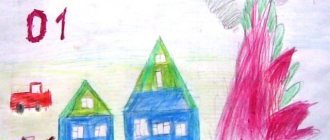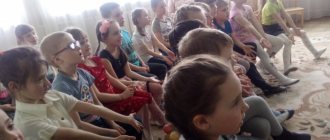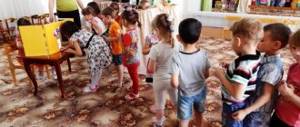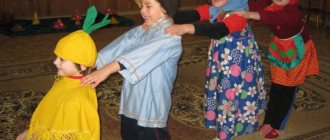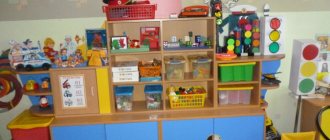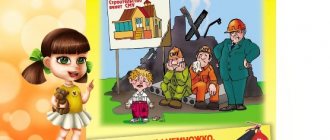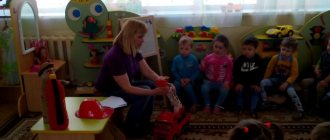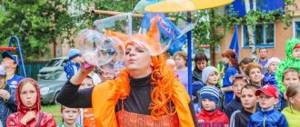Security Prevention
Prevention and training of primary school students in fire safety rules must be carried out by adults in order to avoid an accident.
- Excursions
Usually, on Fire Safety Day in Russia, local branches of the Ministry of Emergency Situations are happy to invite their little guests on an excursion. Fire service employees themselves meet and introduce them to their profession. Firefighters using real equipment demonstrate its operation and explain its operation.
You can explore the building itself, look around the gym, classrooms and recreation room. Firefighters will even wear their gear at speed. Children will be able to ask questions that interest them, and city defenders will even talk about their working days and tell exciting stories.
Of course, the guys will learn not only about the work of firefighters, but also learn safety rules from the professionals themselves. Afterwards, children will be able to go to the museum, which is located at almost every department of the Ministry of Emergency Situations. There, schoolchildren will inspect equipment, clothing and technology.
Fire department museums often hold special courses that teach primary and secondary school students the correct behavior in a burning building, extinguishing small fires, and providing first aid to victims.
In the museum you can feel like a real fireman: employees will teach you how to unwind, use and rewind a fire hose, and tell you about the construction of a gas mask and fire extinguisher.
- At school
The school itself should regularly conduct fire drills. They will teach young schoolchildren to leave the building of an educational institution in an orderly manner, to react seriously to the sound of a siren or bell, and also to save children from unnecessary panic.
Teachers or those in charge should explain to young students the operation and purpose of the fire warning buttons.
These activities greatly reduce the likelihood that your child will fall behind the rest of the class or panic.
Fire safety week at school
Kolosova Svetlana Nikolaevna,
English teacher
MBOU "Nizhneenangskaya Secondary School",
Fire Safety Week
Best Extracurricular Activities
| Fire Safety Week |
The opening of the week was a school-wide assembly, at which those responsible for the DUP squad introduced the children to the plan of upcoming events. The week began with a five-minute meeting dedicated to fire safety. Every day, members of the DUP squad told students about fire safety rules for five minutes, showed them how to use a fire extinguisher, and conducted various quizzes. During the week, according to the approved plan, classes were held on the topic “Actions in case of fire” (grades 1-4), “Causes of fires in everyday life” (grades 5-11). Class teachers conducted fire safety briefings. The life safety teacher conducted training sessions with students and teaching staff in case of fires.
The “Obstacle Course for Young Firefighters” relay race was held among grades 5-7. Two teams “Ogonyok” and “01” took part in the event. The guys impromptu came up with team names, mottos and chose captains. Then they had a relay race, where students performed various tasks related to the work of firefighters. Participants were awarded certificates and sweet prizes.
A sports and educational quiz “You may not be a firefighter...” was held for children in grades 1-4. Guys from the DYUP squad came to visit the children for a physical education lesson and held a quiz. Three teams took part in the game: “Ogonyok”, “Ugolyok” and “Iskorka”. Two teams “Ugolyok” and “Iskorka” won, and team “Ogonyok” took second place. The children were rewarded with certificates and sweet prizes. Roles performed by: DUP squad.
A health worker conducted a conversation on “First Aid for Burns” for junior and senior grades. During the conversation, the children were told about the rules of first aid for burns, and then they were clearly shown how to correctly remove a victim from a fire, apply a bandage and ice. The paramedic also reminded about the rules of behavior during a fire. At the end of the conversation, everyone was treated to vitamins.
Among the 9-11th grades, teachers held a conversation - a quiz “Fire is wonderful, fire is dangerous!” First, the children, using a multimedia presentation, examined the causes of fires, their types, rules of behavior during a fire, rules of behavior in nature, and then showed their knowledge in a quiz.
On the same day, an “Obstacle Course” relay race was held among grades 5-7. Three teams took part in the competition: “Fire Extinguisher”, “Spark” and “Fire”. The teams were determined by drawing lots, they themselves came up with names, team mottos and chose captains. The DUP squad held the following competitions with the children: “Greeting the teams”, captain competition, “Fire brigade training”, “Obstacle course”, “Everything in smoke”, “Rescue”, “Fire fighting”, “Fire hose”. The Fire Extinguisher team won. All teams were awarded certificates and sweet prizes.
In addition, each class prepared information leaflets and leaflets “Fire Safety and Us.” The school librarian took an active part in Fire Safety Week, organizing an exhibition of books in the library “So that there is no trouble” and reviewing literature on the topic “Don’t joke with fire!” for the children.
The results of Fire Safety Week were summed up at a school-wide assembly.
The following events were also included and held in the thematic week program:
1) The DUP detachment spoke at school assemblies in front of grades 5, 6, 7 with the propaganda team “Attention, fire!” on safe handling of fire. Fire is a friend of man, but if it is not controlled, it can immediately turn into a worst enemy. In their speech, the guys called on all schoolchildren to properly handle fire.
2) School teachers also actively participated in fire safety week, participating in a competition of lessons with elements of fire safety.
3) Through biology lessons, a bulletin competition “First Aid for Burns” was held. The best ballots were used for an exhibition in the school Safety Corner.
4) All week, school students actively participated in a preventive street raid in the village of Verkhnyaya Yentala “Identification of fire hazardous places. The raid was carried out in all fire-hazardous areas of the village.
The spring fire safety week was very organized and fruitful.
The students expanded their knowledge about fire safety and came to the conclusion: “It’s easier for us to prevent it than putting out a fire!” We think that all the guys have remembered the rules of safe behavior and will follow them. We really hope that the knowledge acquired during the Week will be strong.
Annex 1
Fire safety week plan.
1. Conducting five-minute meetings during the week on the following topics:
“Fire safety rules”, “Our assistant is a fire extinguisher”, “Spring is a fire-dangerous period”, “First aid for burns”, “You don’t have to be a firefighter...”.
( participants: grades 1-11
).
Responsible for carrying out: DUP squad
.
2. Conducting classes on topics
“Actions in case of fire”
grades 1-5
;
“Causes of fires in everyday life” grades 6-11
3. Competition of lessons with elements of fire safety for teachers
(in a week)
. Report form: title of the lesson topic, fragment of the lesson summary, where elements on fire safety are used, photographs - in electronic form.
4.Competition of information leaflets and leaflets “Fire safety and us”
(during the week) (
participants: grades 5-11
)
5. Relay race “Obstacle course for young firefighters”
(participants: grades 5-8)
Time: 14.50, Wednesday, lesson 7.
Responsible: members of the DUP detachment.
6. Raid on the village of Verkhnyaya Yentala “Identification of fire hazardous areas” ( within a week) .
Responsible: DUP squad
7.
Conversation - quiz “Fire is wonderful, fire is dangerous!” (for students in grades 9-11)
Responsible: head of the DUP squad
8. Sports and educational quiz “You may not be a firefighter...”
(for students in grades 1-4)
Time: physical education lesson in elementary school
Responsible: DUP detachment and detachment leader S.N. Kolosova.
Responsible for carrying out
fire safety weeks:
Kolosova Svetlana Nikolaevna
Appendix 2
Hello, guys, today the guys from the “Young Firefighter” club will play games with you. Let's split into two teams on a count of one to two. “Young Firefighter” relay race for primary school students
- Team names: “Spark” and “Spark”. Choose a captain.
- "Firefighters in training."
You need to run over sheets of paper (two sheets of paper: you stand on one, put the other forward, step on it, take the first sheet, put it forward again and step on it, etc.). Who is faster.
- "Who will save the toy from the fire"
(You need to squat to the hoop, climb through it, then squat again to the chair, take the toy and squat back.)
- "Fire Dogs"
(Give whoever stands on one leg longer a few minutes)
- “Who can fill a fire truck with water faster?”
Captains competition. (you need to inflate the ball, tie it and then burst it, for a while)
- “Hurry, we’re burning!”
(Commanders are in front, the whole team forms a chain, the hands of the person in front lie on the belt of the other, the whole team, without uncoupling, runs to the chair, runs around it, comes back) Who is faster?
- "Who will put out the fire faster"
(each participant needs to run to a chair, take a spoon, scoop up water into it, bring it and pour it into a glass, so each participant). Who will have more water?
- " Do you know?"
The guys must jump rope, run to a chair, say their address, then jump rope. Go back. Who can name more correct addresses with street names, house and apartment numbers?
- "Preparing a fire truck for work"
(You need to run up to a chair, draw one part of the car and come back) Who has the better drawing?
11. Summing up.
Appendix 3
Five minutes: Rules for using a fire extinguisher
Fire extinguisher -
This is a technical device designed to extinguish fires in the initial stages of their occurrence. Every person should know how a fire extinguisher works, how it works, and be able to handle it. In the initial stages of a fire, a fire extinguisher can save lives and property when it is necessary to extinguish a small fire or contain the spread of a fire until firefighters arrive. However, they are useless when putting out large fires.
— Buy a fire extinguisher that you can use to put out a fire when it occurs.
— The fire extinguisher must be of such weight that family members can use it.
Fire extinguishers are divided into the following types:
1. Foam.
For extinguishing flammable liquids (gasoline, oil, varnish, paint) and fires of solid materials in an area of no more than 1 m2, with the exception of energized installations;
2. Powder.
For extinguishing fires of flammable and combustible liquids, varnishes, paints, plastics, electrical installations under voltage up to 1000 volts;
3. Carbon dioxide.
For extinguishing various substances and materials, live electrical installations, and any liquids. These fire extinguishers are unmatched when extinguishing fires in archives and art repositories.
Depending on the nature of the fire extinguisher, its use also varies. Improper use of a fire extinguisher can cause injury. The Main Directorate of the Ministry of Emergency Situations of Russia for the Primorsky Territory reminds of the rules for using fire extinguishers:
Procedure for using powder fire extinguishers:
— first of all, you need to read the instructions printed on the fire extinguisher (it is advisable to read and have an idea when purchasing a fire extinguisher);
- the fire extinguisher must always be in the same place so that it can be used at any time;
If a fire occurs, the following actions must be taken:
- it is necessary to bring the fire extinguisher to the minimum possible and safe distance for extinguishing the fire, taking into account that the length of the fire extinguishing agent jet is 3 m;
- break the seal on the fire extinguisher located on the shut-off and starting device;
- pull the pin;
- direct the hose nozzle to the source of fire;
-press the trigger (lever) on the fire extinguisher;
- wait 3–5 seconds for the fire extinguisher to become ready;
- when the fire extinguishing agent escapes, extinguish the fire.
If a powder fire extinguisher is used in a closed and small space, it is necessary to ventilate the room immediately after stopping the extinguishing process. In addition, one must take into account the possibility of dust formation due to a powder cloud (especially in a small space) and its movement towards the extinguishing agent.
When using a powder fire extinguisher, it is prohibited:
- allow the fire extinguisher to fall and be struck;
- use a fire extinguisher if dents, swellings or cracks appear on the body, shut-off device, as well as in case of leakage of joints;
- when extinguishing a fire, place the fire extinguisher body at a distance of less than 1 m from electrical equipment that is energized;
- when extinguishing a fire with several fire extinguishers at the same time, direct the jets of extinguishing agent towards each other.
Procedure for using carbon dioxide fire extinguishers
- approach the source of the fire (ignition) with a fire extinguisher at a distance of 2 - 3 meters;
- point the bell at the fire;
— remove the seal and pull out the safety pin;
— press the handle button or open the locking device all the way, depending on the modification of the fire extinguisher and the manufacturer;
- upon completion of extinguishing the fire (fire), release the lever (close the valve)
IMPORTANT:
It is forbidden to hold the bell while the fire extinguisher is operating, as it gets very cold, which can lead to frostbite on your hands.
Safety requirements for operating fire extinguishers
The use of fire extinguishers must be carried out in accordance with the recommendations set out in the manufacturer's passports and instructions on actions during the use of fire extinguishers printed on their labels.
Prohibited
:
— operation of fire extinguishers with dents, swelling or cracks in the body, on the shut-off and starting device, on the union nut, as well as in the event of a leak in the connection of the fire extinguisher components and a malfunction of the pressure indicator (for pump-in fire extinguishers);
- strike the fire extinguisher;
— disassemble and recharge fire extinguishers by persons who do not have the right to carry out such work;
- throw fire extinguishers into the fire during intended use and hit them on the ground to activate it;
— direct the fire extinguisher nozzle (flexible hose, nozzle or socket) towards people during its operation;
- use fire extinguishers for needs not related to extinguishing a fire (fire source).
When extinguishing a fire with several fire extinguishers simultaneously, it is not allowed to direct jets of extinguishing agent towards each other.
Prohibited
the use of water and water-foam fire extinguishers to extinguish live equipment, as well as substances that react chemically with water, which is accompanied by intense heat release and splashing of fuel.
Remember:
The continuous operation time of the fire extinguisher OP – 2(z) is 8 seconds, OP – 6(z) – 13 seconds, OP – 9(z) – 14 seconds.
When extinguishing a fire, the fire extinguisher should be held vertically, since the horizontal position does not ensure full use of its charge.
Used fire extinguishers (even if their charge is not fully used), as well as fire extinguishers with broken seals, must be immediately sent for recharging.
